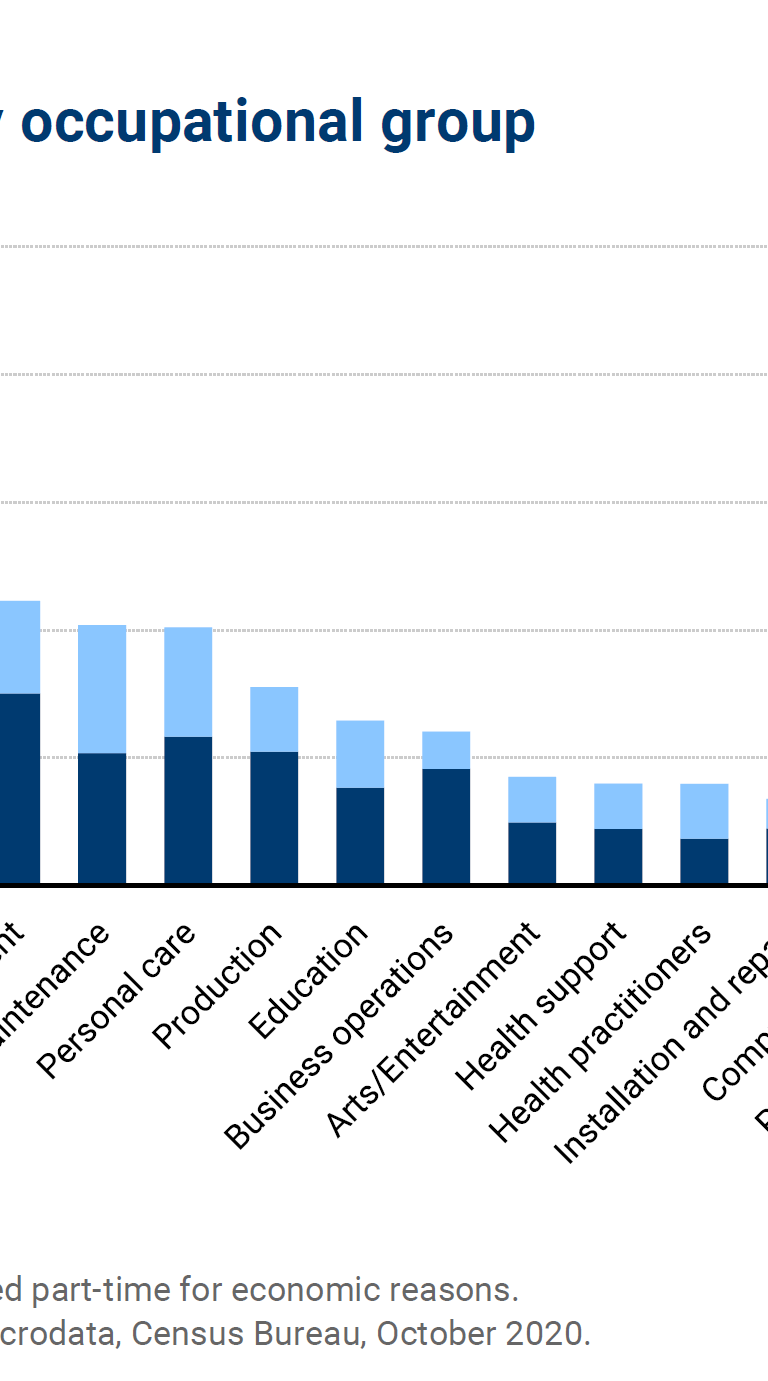Summary
As COVID-19 continues to take a toll on the economy, America faces three interrelated challenges: (1) high unemployment alongside a historically low reemployment potential; (2) a precarious labor market with too many low-wage, dead-end jobs; and (3) large infrastructure gaps that hamper productivity and growth.
The Biden administration has a historic opportunity to tackle the first two by addressing the third. A large-scale federal infrastructure investment program that is deliberately designed for maximum workforce impact can help accelerate reemployment, prevent scarring, and boost long-term inclusive and sustainable growth.
To maximize employment and opportunity for workers, policymakers should consider not only how many jobs these investments could create, but also how good the jobs are likely to be, who they will likely employ, and to what extent targeted reskilling might be needed to fill staffing gaps.
Below, we illustrate how this effort could take shape by describing an approach to assess and potentially maximize the workforce benefits of infrastructure investments and present a case study on broadband expansion.
A triple whammy of crises
America faces three interrelated challenges in the wake of the COVID-19 pandemic.
First, the U.S. economy has experienced severe job losses, with almost 10 million fewer workers employed today than before the pandemic (see Figure 1). In addition to increased unemployment, labor force participation has dropped steeply, as discouraged Americans leave the workforce entirely. Largely because COVID-19 has disproportionately disrupted high-contact occupations (e.g., cleaning, hospitality, and food services), the shock has hit low-wage workers—who are more likely to be Black, Hispanic, female, and young—the hardest. To make matters worse, these workers are having the hardest time getting back on their feet, because the occupations they have experience in have not historically offered pathways into today’s in-demand occupations. The economy’s potential to absorb displaced workers is at its lowest level since at least 2004 (the first year we can measure it). As we wrote in November, “Any of today’s unemployed workers may find it harder than in the past to find new jobs and advance through the labor market.” And the longer these workers remain unemployed, the less employable they will become—a phenomenon known as “scarring.”

Second, even before the pandemic, the U.S. labor market was incredibly precarious. Prior to COVID-19, almost half of the American workforce (44 percent or 54 million workers) earned low wages, with a median annual salary below $18,000. About half of low-wage workers had a high school diploma or less, with only 14 percent holding a bachelor’s degree. Moreover, our research has shown that most low-wage workers churn through low-wage jobs, struggling to move up in a labor market with declining and uneven access to development and advancement opportunities—and that women and people of color have been disproportionately affected by waning job quality and economic mobility.
Third, the U.S. economy is host to large and persistent infrastructure gaps that hamper productivity and long-term growth. The American Society of Civil Engineers gives U.S. infrastructure a score of C-, classifying it as “poor” and “at risk,” while the World Economic Forum’s Global Competitiveness Report ranks it 13th in the world. Public spending on physical infrastructure has persistently failed to keep up with economic growth; the U.S. spends only 2.3 percent of GDP on infrastructure, while European countries spend 5 percent on average and China spends about 8 percent. Just to meet basic national needs by 2025, the U.S. faces an estimated funding shortfall of more than $2 trillion. Several more trillions in spending on clean energy and climate change adaptation and mitigation will be needed to achieve carbon neutrality by 2050.
Amid economic and social disruption, policymakers must take bold actions to accelerate reemployment while building a productive, resilient, low-emission economy that can deliver dignity, stability, and opportunity for all workers.
Seizing the moment
The Biden administration recognizes the potential for a well-designed, large-scale federal infrastructure investment program to close critical gaps, put Americans back to work, and correct economic, racial, and social inequities in employment. Incorporating a workforce lens to federal infrastructure investments can ensure they address all three of these crises simultaneously.
The case for using infrastructure spending as a countercyclical macroeconomic stabilization tool is not new. The rationale traces back to President Herbert Hoover and was later crystallized by John Maynard Keynes, who posited that public spending can offset downturns by boosting labor demand when unemployment is high. President Franklin D. Roosevelt’s New Deal put this theory to the test. A gargantuan effort with an enduring legacy, the initial appropriation for New Deal infrastructure projects under the Works Progress Administration (WPA) represented 6.7 percent of GDP—equivalent to $1.4 trillion today. At its peak, the WPA provided paid work for up to 40 percent of unemployed Americans, equivalent to about 4 million jobs today.
Beyond short run job creation, federal infrastructure investment can have several other positive effects. Boosting employment would increase aggregate demand and could put upward pressure on wages. As many studies have shown and policymakers increasingly recognize, running a high-pressure economy can be an effective way to reduce income inequality and narrow racial and gender wage gaps (provided it’s accompanied by complementary policies). Moreover, improving the nation’s infrastructure would increase long-run productivity growth. Finally, even if infrastructure investment had no impact on employment, productivity, and growth, it’d still deliver public goods that should be available to all but that may not be profitable to produce privately (such as rural broadband). Since many of the benefits of infrastructure spending are externalities—meaning that they accrue to society as a whole and individuals cannot be easily prevented from enjoying them—government provision is often efficient.
Despite approving trillions of dollars in COVID-19 relief to avert mass unemployment, Congress has allocated comparatively little for infrastructure spending. By contrast, America’s main peers and competitors all plan to massively increase infrastructure investment. The U.S. failure to follow suit is puzzling given infrastructure’s public support and bipartisan appeal; during a divisive election year, both 2020 presidential campaigns supported $1.5 trillion to $2 trillion increases in infrastructure spending.
Historically low interest rates offer plenty of fiscal space for the government to spend on high multiplier activities like infrastructure without crowding out private investment—especially if such spending can accelerate reemployment, prevent scarring and support long-term inclusive growth. As the Biden administration and the 117th Congress consider further stimulus, they would be wise to take advantage of this momentous opportunity.
Jobs, good jobs, jobs for all
The case for a large-scale federal infrastructure program as a means to putting people to work while confronting inequities is strong. To realize these goals, policymakers may want to select projects that are not only economically worthwhile, socially beneficial, and politically feasible, but also that are intensive in the kind of labor that is currently idle. Compared to New Deal efforts, the scope for easy job creation is more limited today; while WPA projects employed large numbers of unskilled workers, current infrastructure projects are likely to be much more capital- and skill-intensive. Thus, a key variable is how the selected projects match the currently unemployed workforce in order to maximize reemployment and opportunity dividends.
As policymakers contemplate the pros and cons of different infrastructure projects, they should consider three important questions:
How many and what kinds of workers will they employ?
The answer depends on a complex web of factors, not least on the government’s choice of priorities and spending on each. Once policymakers have narrowed down a list of priorities, they must assess the scale of the needs (e.g., 2,000 miles of roads, 400 bridges, etc.) and put a price tag on them.
Armed with these spending assessments, policymakers can then estimate how many workers each project will require, by geography and by occupation. Each project will require a unique occupational mix, and occupations employ different kinds of workers and have different characteristics—such as current employment, demand, pay, barriers to entry, mobility prospects, etc. These will affect how much a project costs and how quickly it can be staffed, among others.
Understanding the characteristics of the workers currently employed in the occupations that projects will require is key to estimating the extent to which federal investments might create equitable employment opportunities for historically marginalized communities. Some occupations (such as management and engineering) disproportionately employ older white men, while others (such as food prep and retail sales) disproportionately employ young Black and Hispanic women. As noted above, occupations with large shares of women and minority employees have been hit much harder by the COVID-19 crisis. At the same time, our research has found that most infrastructure occupations disproportionately employ older white men. Given this occupational segregation, creating equitable employment opportunities may be difficult. This is in line with findings by our colleague Joseph Kane, who proposes diversity and inclusion focused sector strategies, work-based learning programs, and supportive services to address inequities in infrastructure jobs.
How good will the jobs be?
Occupations also differ in the extent to which they offer accessible, high-quality, and future-proof employment opportunities. Some occupations require a bachelor’s degree or higher, while others have no formal education requirements. Some pay a living wage and offer benefits like health insurance, while others don’t pay enough to make ends meet. Some offer pathways to upward mobility, while others are dead-end jobs. Given the urgency to accelerate reemployment, policymakers may favor investments that create jobs with low natural barriers to entry and that provide a living wage, basic labor protections, and stability. Our research finds that most infrastructure jobs are well paid (above the national median), stable, and accessible to workers without college degrees.
What reskilling may be required?
Workforce impact analysis can help answer a key question: How many unemployed and underemployed workers can a potential project absorb? This requires comparing, for each occupation required by a project, the number of jobs estimated to be created with the number of workers currently unemployed and underemployed. Some occupations (such as retail sales) are so large or have been hit so hard by the COVID-19 shock that enough qualified workers will be available to fill the created positions. In other occupations, however, there may not be enough idle qualified workers to meet projected demand (see Figure 2).
If staffing shortages exist, projects could fill them by hiring unemployed and underemployed workers in similar occupations who could feasibly transition to the required occupations with little to no reskilling. One way to identify these similarities—or occupational “adjacencies”—is to examine historical data on the flow of workers between occupations. These transitions represent implicit skill overlaps; if there are not enough unemployed workers in a required occupation, workers in adjacent occupations could potentially be absorbed without major reskilling. Policymakers can leverage tools like Mobility Pathways, developed by the Workforce of the Future initiative, to trace common pathways into and out of 441 occupations across 130 industries. To maximize absorption, employers will need to be proactive and consider workers from “adjacent” occupations who may not fit the job description but have historically transitioned into the required occupations.
If enough idle workers cannot be found in adjacent occupations to meet the projected staffing demands of a potential infrastructure project, it may be necessary to hire and train unemployed and underemployed workers from non-adjacent occupations. To do this quickly and cost-effectively, policymakers can target workers with the smallest occupational distance to the required occupations.
Estimating reskilling needs can help streamline and inform training programs. These estimates would be especially helpful for community colleges and other small local training providers. An efficient reskilling architecture featuring pre-apprenticeship and community-based programs would allow education and training providers to focus on skills differentials and address only the incremental skills that workers will need, enabling more rapid and cost-effective scaling of high-quality training that leads to employment.
The next section applies the analytical framework described here to a hypothetical broadband expansion project.
Workforce analysis case study: Broadband expansion
Between 21 million and 43 million Americans lack access to high-speed broadband internet. The digital divide plays out along racial, socioeconomic, and geographic lines, to the detriment of the country’s most marginalized communities. This gap is especially harmful in light of digital connectivity’s growing importance—only heightened by COVID-19—for access to employment, education, and health services. As this reliance grows, it threatens to exclude the most vulnerable from opportunity.
To address this critical deficit, President Biden’s platform calls to “Expand broadband, or wireless broadband via 5G, to every American.” In Congress, the Accessible, Affordable Internet for All Act (2020), sponsored by Rep. James E. Clyburn, proposes investing $80 billion to deploy high-speed broadband infrastructure nationwide. We estimate that this spending would create approximately 200,000 job-years in about 130 occupations, principally in Installation, Maintenance, and Repair occupations. The following table breaks down estimated job creation for the top six highest-volume, most critical (i.e., those with the highest relative intensity of employment in broadband) occupations:
Table 1. Estimated job creation by occupation for broadband
| Top broadband occupations | % of jobs | # of jobs |
| Telecommunications equipment installers and repairers, except line installers | 13.5 | 26,357 |
| Telecommunications line installers and repairers | 9.2 | 18,437 |
| Electrical power-line installers and repairers | 4.1 | 8,282 |
| Electronics engineers, except computer | 2.2 | 4,374 |
| Radio, cellular, and tower equipment installers and repairers | 0.8 | 1,626 |
| Helpers—installation, maintenance, and repair workers | 0.3 | 582 |
The typical broadband worker is a prime-age (25-54 years) non-Hispanic white male without a four-year college degree. Compared to the general workforce, broadband workers are more male, older, have less formal education; they are also better paid, more likely to work full-time, more likely to be covered by a union, and face lower barriers to entry. Compared to the current unemployed and underemployed population, they are also more likely to be white. On the flip side, broadband occupations offer limited pathways to higher-paying jobs and are expected to grow less over the next decade than most other occupations.
If all 200,000 of these hypothetical jobs were created at once, we estimate that about 169,000 positions could be filled by currently unemployed and underemployed workers in broadband occupations. In the most critical broadband occupations (which would employ a subset of 60,000 workers), displayed in Figure 3, there are not enough currently unemployed and underemployed workers to meet the estimated demand surge. These shortages could be partially filled by currently unemployed and underemployed workers from adjacent occupations such as Electricians, Engineers, A/V Equipment Installers and Repairers, and Construction Laborers (7,000 “Transitions” workers), who could feasibly transition to the requisite occupations with little to no reskilling. But as Figure 3 shows, significant gaps would remain, particularly in four critical broadband occupations. For these, workers would need to be trained or reskilled. To minimize costs and ramp-up time, this reskilling should target workers from occupations with the shortest skill distance.
The potential for the project to absorb currently unemployed workers and the extent to which reskilling would be required depends on how job creation is distributed over time. If all 200,000 job-years were created in the first year, 40 percent of those in the six most critical occupations would require reskilling. By comparison, a phased approach that created 50,000 jobs in the first year that would last four years may require no major reskilling, because all the jobs created could potentially be filled by currently unemployed and underemployed workers in the required occupations. Targeted reskilling would still be required given that the geographic distribution of the currently unemployed and underemployed may not match where the jobs are located, or concurrent investments created additional demand for these occupations. This type of scenario can help policymakers assess feasibility, timing, and the effects on displaced workers of infrastructure investments at a local level.
Conclusion
While our estimates are for illustrative purposes and subject to significant uncertainty, workforce analysis can be a useful tool for assessing the potential workforce implications of infrastructure investments. At the same time, job creation should not be the sole or primary goal of a federal infrastructure program, particularly since unemployment levels could be significantly lower by the time Congress and the Biden Administration agree on a bill. Instead, policymakers should prioritize projects that address large, urgent, and currently unmet national needs, and that are economically and politically viable—such as climate change mitigation, universal healthcare, and quality education, all of which pay for themselves in the long run and enjoy broad popular support.
That said, workforce impact is an important second-order concern that should enter into policymakers’ cost-benefit and feasibility analyses. This does not simply mean maximizing total job creation; policymakers must also address the challenges and frictions faced by workers as they try to transition to jobs created by large-scale federal investments.
Policymakers must act swiftly if they want to take advantage of this watershed opportunity. If history is any guide, the window won’t be open for long.
The Brookings Institution is committed to quality, independence, and impact.
We are supported by a diverse array of funders. In line with our values and policies, each Brookings publication represents the sole views of its author(s).









